Unfortunately, Microsoft seems to be unable to remove references of child porn from Bing. This is not the first time the search engine has come under fire for allowing such searches. Microsoft said in 2018 it was working to solve the problem but in 2019 it persists. According to a report in the New York Times, several tech companies are failing to address the availability of child pornography on their platforms. Microsoft’s inability to tackle the content seemingly flies in the face of the companies track record. Certainly, Redmond has been among the most proactive in terms of filtering our abusive imagery, hate speech, and other harmful content. Microsoft has done more than the likes of Facebook to tackle the issue. A decade ago, Microsoft released PhotoDNA, an image fingerprint tool that allows online services to avoid images of child abuse. This is achieved by pre-screening uploaded content. Earlier this year, Indian authorities stirred controversy by suggesting PhotoDNA be used to scan all user images.
Continued Lapse
Despite Microsoft’s efforts in many areas, it seems Bing is still a safe haven for criminals peddling child porn. Earlier this year, AntiToxin It found that a number of obvious child pornography terms, including “porn kids” led to the display of illegal imagery on the search engine. In other cases, users searching for variations of “Omegle Kids” were autocompleted to “Omegle Kids Girls 13” and “Kids on Omegle Showing”. Safe search on Bing was admittedly switched off in this study. However, it still exposed a massive problem in the search engine.




